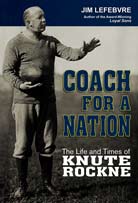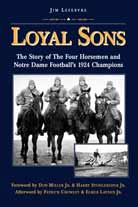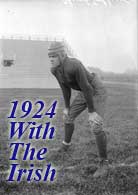In the fall of 1909, upstart Notre Dame went to Ann Arbor to take on Fielding Yost’s mighty Michigan.
As Notre Dame prepares to travel to Ann Arbor for Saturday’s battle with Michigan that could set the tone for the 2009 season, it’s time to remember the first great centennial in Notre Dame football history.
It was 100 years ago this fall that Notre Dame scored its first victory over mighty Michigan, projecting ND football onto a path that would eventually put the Irish into a virtual tie with the Wolverines as college football’s two winningest programs.
The football fortunes of the two schools were intertwined from the beginning. An 8-0 loss to the Wolverines in 1887 is ND’s first officially recorded game. The following spring, a Michigan squad came to South Bend and helped teach the game to ND, winning a pair of games by scores of 26-6 and 10-4.
Michigan firmly established itself as “champion of the West”, especially under legendary coach Fielding Yost. In Yost’s first four seasons at Ann Arbor (1901-04), his squads went 43-0-1, claimed four national titles and scored at such a clip that they were known as the “point a minute” teams. Among those victories was a 23-0 trimming of ND in a game played at Toledo, Ohio, in 1902.
Through the 1908 season, Yost had piled up an overall mark of 69-5-2. But it was the 1908 game against Notre Dame, a fierce kicking battle won by Michigan 12-6, that gave a hint as to what could happen in 1909.
Taking over the reigns as coach at Notre Dame in ’09 was Frank “Shorty” Longman, a fullback for Yost in 1903-05. He got the Irish off to a strong start with wins over Olivet, Rose Poly and the Michigan Aggies, before heading to a challenging road test at powerful Pittsburgh. There, ND made a strong impression by upsetting the Panthers, 6-0.
Michigan sent an assistant coach to Pittsburgh to scout Notre Dame, but Longman was able to defeat Pitt without using several of his favorite short pass plays, and hardly relying on All-American back Harry “Red” Miller.
That would change the following Saturday, November 6, at Ann Arbor’s Ferry Field, where 6,000 fans gathered to see the big battle.
After an early ND fumble, Michigan’s Dave Allerdice – the kicking star of the 1908 game – nailed a 20-yard kick for a 3-0 lead.
Later in the first half, ND’s Miller – the oldest of the five football-playing brothers from Defiance, Ohio – put on an individual show that would wow the assembled audience. Play after play, the shifty redhead got the ball from Irish quarterback Don Hamilton, and Miller responded by reeling off a series of gains that brought the ball from midfield down to the Michigan two-yard line.
Miller, it was said, was exhausted and told Hamilton he needed a rest. So the Irish signal-caller turned to fullback Pete Vaughan to attempt the final assault on the Wolverine goal. One charge, then another, by Vaughan bulled the ball to within inches of the goal line. One more try was left (as teams had only three downs to gain a first down at the time).
Wrote one reporter covering the game:
“Six thousand people went silent. Up in the bleachers, Hamilton’s voice could be heard, snapping out the signals.”
Again, the ball went to Vaughan, who made a charge off to the right side. A great pile of humanity landed near the base of the goal post.
“The players disentangled themselves. They stood up in a close circle and none but they could see where the ball had stopped. Referee Hoagland elbowed his way through the panting, padded players…Then the knot of players gave way. Yelling, dancing like madmen, the Notre Dame players ran down the field. Vaughan laid with his back on the goal line and hugged the ball to his chest. And the ball was across the chalk line.”
Notre Dame had a 5-3 lead (a touchdown being worth five points) after missing the conversion.
Down through the years, the description of Vaughan’s touchdown would receive some embellishment. He hit the Michigan line so hard that the goalpost left an imprint on his jersey. Or, he hit the goalpost so hard he actually dislodged the wooden post. Rev. Matthew Walsh, Notre Dame’s president in the early 1920s, made it a point of telling and re-telling the story of Pete Vaughan and the Michigan goalpost, to assembled gatherings of ND students.
But broken goalpost or not, the determination of Pete Vaughan to break through the line of mighty Michigan stands as one of the pivotal moments in Notre Dame’s football history.
And, as the first half ended, Notre Dame had outgained Michigan by an estimated total of 200-45, using an array of quick passes and end runs to befuddle the Wolverines. The first half sent Yost into a rage at halftime, imploring his charges to fight with typical Michigan fire.
His second-half strategy was one that was tried and true – employing the kicking game to win the battle of field position. It meant a series of punts, mostly on first down, to try to pin Notre Dame in the shadow of its own end zone, forcing return punts and gaining a few yards on each exchange.
Late in the second half, with ND still ahead 5-3, Michigan’s strategy paid off when the Irish lost a fumble at their own 15-yard-line. The Wolverines were poised for the kill. Two plays netted nine yards, setting up a short field goal attempt for the lead.
Later, Red Miller described the scene along the Irish line this way:
“Each man was set, like a tiger about to spring, his body taut, his face grim, his lips drawn back, his teeth flashing, a picture of power and determination. Confidence took possession of me. It was deadly quiet, then suddenly it was broken. ‘We’re going through,’ someone called loudly.”
And they did. The Irish line blocked the kicked, and fell on the loose ball. In the closing minute, ND added another touchdown.
And that’s how it ended: Notre Dame 11, Michigan 3.
Back on the Notre Dame campus, students erupted in joy. A large bonfire lit the night sky as the entire Notre Dame community celebrated.
Sports writer E. A. Batchelor wrote in the Detroit Free Press: “Eleven fighting Irishmen wrecked the Yost machine this afternoon,” thus helping spread the use of a new nickname for the football players of Notre Dame.
The rest, as they say, is history.






